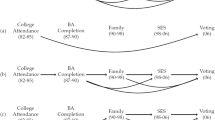Abstract
Lijphart (1997) endorses compulsory voting as a means to increase voter turnout. Considering the likely effects of the role of information (including its costs) on the decision to vote and taking an expressive view of voting, however, compels us to investigate two unexamined claims by such advocates: (i) that individuals are transformed by forcing them to vote, and (ii) that a compulsory electoral outcome is a more accurate reflection of community preferences.We argue that compelling those who are not particularly interested in, or informed about, the political process to vote increases the proportion of random votes and we show that under simple majority rule, compulsory voting may violate the Pareto principle; the less popular candidate is more likely to be elected. Our results cast doubt on the ”miracle of aggregation“ argument, which optimistically concludes that as long as uninformed votes are not systematically biased, they will have no effect on voting outcomes. We also briefly consider how information cascades can exacerbate this problem.
Similar content being viewed by others
References
Abraham, H. (1955). Compulsory Voting. Washington DC: Public Affairs Press.
Aldrich, J. (1997). “When is it rational to vote?” In D. Mueller (Ed.), Perspectives on Public Choice: A Handbook. Cambridge: Cambridge University Press.
Andrews, L., Jakee, K., & Fry, T. (2001). “Compulsory voting: Some basic analytics and a test from Australia.” Presented at American Political Science Association's Annual Meeting, (Sep). San Francisco.
Ashenfelter, O., & Kelley, S. Jr. (1975). Determinants of participation in presidential elections. Journal of Law and Economics, 18(Dec), 695–733.
Bikhchandani, S., Hirshleifer, D., & Welch, I. (1992). A theory of fads, fashion, custom and cultural change as informational cascades. Journal of Political Economy, 100(5), 992-1026.
Blais, A., & Young, R. (1999). Why do people vote? An experiment in rationality. Public Choice, 99, 39–55.
Brennan, G., & Buchanan, J. (1984). Voter choice: Evaluating political alternatives. American Behavioral Scientist, 28, 185–201.
Brennan, G., & Hamlin, A. (1998). Expressive voting and electoral equilibrium. Public Choice, 95, 149–175.
Brennan, G., & Lomasky, L. (1993). Public Democracy and Decision: The Pure Theory of Electoral Preference. Cambridge University Press.
Crain, W. M. (1995). The right versus the obligation to vote: Rejoinder to Yeret, and O'Toole and Strobl. Economics and Politics, 7(3), 281–287.
Crain, W. M., & Leonard, M. (1993). The right versus the obligation to vote: Effects on cross-country government growth. Economics and Politics, 5(1), 43–52.
Dharmapala, D., & Palda, F. (2002). Are campaign contributions a form of free speech? Evidence from recent house elections. Public Choice, 112, 81–114.
De Winter, L., & Ackaert, J. (1998). Compulsory voting in Belgium: A reply to Hooghe and Pelleriaux. Electoral Studies, 17(4), 425–428.
Downs, A. (1957). An Economic Theory of Democracy. New York: Harper.
Federal Election Committee (FEC). (2003a). “1996 Popular vote summary.” http://www.fec.gov/pubrec/fe1996/summ.htm. Accessed October 2004.
Federal Election Committee (FEC). (2003b). “Voter Registration and Turnout–1996.” http://www.fec.gov/pages/96to.htm. Accessed October 2004.
Fiorina, M. (1976). The voting decision: instrumental and expressive aspects. Journal of Politics, 38, 390–415.
Hooghe, M., & Pelleriaux, K. (1998). Compulsory voting in Belgium: An application of the Lijphart thesis. Electoral Studies, 17(4), 419–424.
Hughes, C. (1966). Compulsory voting. Australian Journal of Political Science, 1(2), 81–95.
Jackman, R. (1987). Political institutions and voter turnout in the industrial democracies. American Political Science Review, 81(2), 405–423.
Jackman, S. (1999). Non-compulsory voting in Australia? What surveys can (and can't) tell us. Electoral Studies, 18, 29–48.
Jones, W. H. M. (1954). In defence of apathy: Some doubts on the duty to vote. Political Studies, 2(1), 25–37.
Kan, K., & Yang, C. C. (2001). On expressive voting: Evidence from the 1988 presidential election. Public Choice, 108, 295–312.
Kirman, A. (1993). Ants, rationality and recruitment. Quarterly Journal of Economics, (Feb), 137–156.
Lacy, D., & Burden, B. C. (1999). The vote-stealing and turnout effects of Ross Perot in the 1992 U.S. Presidential election. American Journal of Political Science, 43(1), 233–255.
Lijphart, A. (1997). Unequal participation: Democracy's unresolved dilemma. American Political Science Review, 91(1), 1–14.
Lohmann, S. (1994). The dynamics of informational cascades: The Monday demonstrations in Leipzig, East Germany, 1989–91, World Politics, 47, 42–101.
Mackerras, M., & McAllister, I. (1999). Compulsory voting, party stability and electoral advantage in Australia. Electoral Studies, 18, 217–233.
Massicotte, L., Blais, A., & Yoshinaka, A. (2003). Establishing the Rules of the Game: Election Laws in Democracies. Toronto: University of Toronto Press.
Matsusaka, J. (1995). Explaining voter turnout patterns: An information theory. Public Choice, 84, 91–117.
Matsusaka, J., & Palda, F. (1999). Voter turnout: How much can we explain? Public Choice, 98, 431–446.
McAllister, I. (1986). Compulsory voting, turnout and party advantage in Australia. Politics, 21(1), 89–93.
McAllister, I., & Makkai, T. (1993). Institutions, society or protest? Explaining invalid votes in Australian elections. Electoral Studies, 12(1), 23–40.
Mueller, D. (1987). “Voting paradox.” In C. Rowley (Ed.), Democracy and Public Choice: Essays in Honor of Gordon Tullock. Oxford: Basil Blackwell.
Mueller, D. (2003). Public Choice III. New York: Cambridge University Press.
O'Toole, F., & Strobl, E. (1995). Compulsory voting and government spending. Economics and Politics, 7(3), 271–280.
Palfrey, T., & Poole, K. (1987). The relationship between information, ideology, and voting behavior. American Journal of Political Science, 31(3/Aug), 511–530.
Powell, B. (1986). American voter turnout in comparative perspective. American Political Science Review, 80(1/Mar), 17–43.
Wertheimer, A. (1975). “In defense of compulsory voting.” In Pennock, J. R. and Chapman, J. (Eds.), Participation in Politics. New York: Lieber-Atherton.
Wolfinger, R., & Rosenstone, S. (1980). Who Votes? New Haven: Yale University Press.
Yeret, E. (1995). Dictators, democracies, & voters: A comment on the right versus the obligation to Vote. Economics and Politics, 7(3), 263–270.
Author information
Authors and Affiliations
Corresponding author
Rights and permissions
About this article
Cite this article
Jakee, K., Sun, GZ. Is compulsory voting more democratic?. Public Choice 129, 61–75 (2006). https://doi.org/10.1007/s11127-005-9008-6
Received:
Accepted:
Published:
Issue Date:
DOI: https://doi.org/10.1007/s11127-005-9008-6




